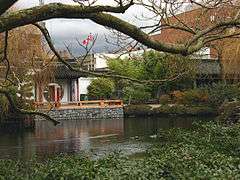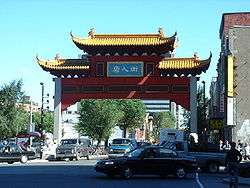Chinatowns in Canada
| Chinatown | |||||||
|
Toronto Chinatown | |||||||
| Chinese | 唐人街 | ||||||
|---|---|---|---|---|---|---|---|
| |||||||
| Alternative Chinese name | |||||||
| Traditional Chinese | 中國城 | ||||||
| Simplified Chinese | 中国城 | ||||||
| |||||||
| Second alternative Chinese name | |||||||
| Traditional Chinese | 華埠 | ||||||
| Simplified Chinese | 华埠 | ||||||
| |||||||
| Chinatowns |
|---|
Chinatowns in Canada generally exist in the large cities of Vancouver, Ottawa, Calgary, Toronto, and Montreal, and existed in some smaller towns throughout the history of Canada. Prior to 1900, almost all Chinese were located in British Columbia, but have spread throughout Canada thereafter. From 1923 to 1967, immigration from China was suspended due to exclusion laws. In 1997, the handover of Hong Kong to China caused many from there to flee to Canada due to uncertainties. Canada had about 25 Chinatowns across the country between the 1930s to 1940s, some of which have ceased to exist.[1]
History
_in_Mountains%2C_1884.jpg)
Chinatowns have existed in Canada since the 1850s, with the first recorded visit in 1788.[2] The first Chinese landed on the Canadian west coast in 1788 and have integrated with the Canadian multicultural society.[3]
Major timeline for Chinese Canadian history is:[3]
- 1788 - First recorded Chinese visitor in Canada
- 1858 - Fraser River Gold Rush
- 1861 - First Chinese Canadian born
- 1872 - Disenfranchisement of Chinese in British Columbia
- 1880s - Canadian Pacific railway employs many Chinese
- 1923 - Chinese exclusion laws passed, causes hardships for Chinese Canadians
- 1947 - Chinese franchised, many entered into politics
- 1967 - Immigration from China liberalized
- mid 1980s to 2000 - Hundreds of thousands of Hong Kong people flee to Canada because they feared threats from the PRC would betray the Sino-British Joint Declaration and turn Hong Kong into a mainland Chinese city, suppressing and discriminating Hong Kong people.
Demographics

Canadians of Chinese descent, including mixed Chinese and other ethnic origins, make up about four percent of the Canadian population, or about 1.3 million people as of 2006.[4] The Chinese Canadian community is the largest ethnic group of Asian Canadians, consisting approximately 40% of the Asian Canadian population. Most of them are concentrated within the provinces of Ontario and British Columbia. The five metropolitan areas with the largest Chinese Canadian populations are the Greater Toronto Area (537,060), Greater Vancouver (402,000), Greater Montreal (120,000), Calgary Region (75,410), and the Edmonton Capital Region (53,670).[5]
Alberta
Edmonton (c. early 1900s)
Chinatown and Little Italy is a business revitalization zone (BRZ), created by the City of Edmonton, roughly comprising the informal Chinatown and Little Italy ethnic enclaves in the city's inner neighbourhoods. The boundaries of the BRZ includes only the "commercial strips" within those enclaves, and the BRZ itself strattles the official neighbourhoods of McCauley and Boyle Street.[6]
Calgary (c. 1910)

The Chinatown in Calgary is the largest in Alberta. It spans 1 St E westward to 10 St W and from the Bow River southward to 4 Ave SW. This Chinatown consists of a large shopping centre called Dragon City Mall and a Calgary Chinese Cultural Centre located at 1 St SW. Nearly all of this is post-1930s, as Calgary's original Chinatown was little more than a handful of "Chinese and Western" restaurants in the same area, without the historic Chinese-ethnic residential-commercial quality of more historic Chinatowns like those in Vancouver and Victoria.[2] This city also has a Japantown on 29th Street SW.
Lethbridge (c. 1910s)
Lethbridge has the remains of a once thriving Chinatown. The Kuomintang and Chinese Freemasons buildings are about all that remain on 2 Ave South near 4 Street South. By the 1960s, Chinese residents began moving out of the area, and by the end of the 20th century, all but one resident — Albert Leong, owner of Bow On Tong — had moved out, and Chinatown was reduced to one block with only a handful of buildings.[2]
British Columbia
Vancouver
Chinatown in Vancouver, British Columbia is Canada's largest Chinatown. Centred on Pender Street, it is surrounded by Gastown and the Downtown Financial and Central Business Districts to the west, the Downtown Eastside to the north, the remnant of old Japantown to the northeast, and the residential neighbourhood of Strathcona to the east. The approximate street borders of Chinatown's official area as designated by the City of Vancouver are the alley between Pender Street and Hastings, Georgia, Gore, and Taylor Streets,[7]
Victoria

The Chinatown in Victoria, British Columbia is the oldest in Canada and second in age only to San Francisco's in North America, with its beginnings in the mass influx of miners from California to what is now British Columbia in 1858. Its history goes back to the mid nineteenth century. It remains an active place for Chinese-Canadians, Victoria residents and tourists. Victoria's Chinatown is now surrounded by cultural, entertainment venues as well as being a venue itself.[8]
Other Chinatowns in British Columbia
- New Westminster's Chinatown disappeared after 1898 fire.
- Cumberland's Chinatown – once the second-largest on the West Coast of North America (c.1910) and disappeared in the 1970s.[9]
- Historical Chinatowns in Nanaimo
- Stanley, British Columbia – a gold-mining community near Barkerville which became the largest town in the Cariboo goldfields after Barkerville's decline. In 1900 well over half its population was Chinese. Other towns in the Cariboo goldfields were also noticeably Chinese in composition – Richfield, Antler and others. Settlements in other areas which had Chinatowns, or which became predominantly Chinese for some of their lifespan, were Hazelton, Boston Bar, Lillooet, Rock Creek, Granite Creek and Fisherville (Wild Horse Creek). Cities which had now-vanished Chinatowns included Nanaimo and Penticton.[2]
Manitoba
Winnipeg
Chinatown in Winnipeg, Manitoba was formed in 1909.[10] Located on King Street between James and Higgins Avenues, it was officially recognized in 1968. Winnipeg's Chinatown is home to many shops and restaurants including Asian grocery stores and an herbal products store.[10]
Ontario
Ottawa
Ottawa's Chinatown is located along Somerset Street in downtown Ottawa. It runs from Bay Street in the east to Rochester St in the west (according to the Chinatown BIA). Signs for Chinatown continue along Somerset until Preston Street, and Chinese/Asian restaurants can be found even further west.[11]
Greater Toronto Area
Greater Toronto has several cities with concentrated Chinese establishments and Chinatowns. The most important one is within Downtown Toronto, Ontario, with a high concentration of ethnic Chinese residents and businesses extending along Dundas Street West and Spadina Avenue. This city also has a Koreatown for Korean Canadians. First developed in the late 19th century, this Asian ethnic enclave is now one of the largest Chinatowns in North America and one of several major Chinese-Canadian communities in the Greater Toronto Area. Notably, Toronto's neighbouring cities of Mississauga and Markham also host a number of large Chinese business centres, plazas and malls, albeit no single defined Chinatown.
Windsor
Windsor's West Side neighborhood is home to a Chinatown.[12] Many Asians Americans who long for Chinese food from Detroit often visit this Chinatown, alongside Chicago and Toronto.[13]
Other Chinatowns in Ontario
Hamilton and Sudbury were also once home to a Chinatown.[14][15]
Quebec

Montreal
Chinatown in Montreal is located in the area of De la Gauchetière Street in Montreal. The neighborhood contains many Asian restaurants, food markets, and convenience stores as well being home to many of Montreal's East Asian community centres, such as the Montreal Chinese Hospital and the Montreal Chinese Community and Cultural Center.[16]
Quebec City
There was once a Chinatown on Côte d'Abraham in Quebec City, but Autoroute Dufferin-Montmorency cuts through what was once its location. Historically, it paled in size in contrast to its somewhat larger counterpart in Montreal. The first Chinese residents arrived in the late 19th Century. Most Chinese in the area operated business catering to their own: opium dens, mah-jongg, and Chinese laundries. The area peaked in the 1940s and 1950s. The separatist movement caused many to leave in the 1980s and 1990s. Some restaurants and a few Chinese residents remain. Most of them moved to either Montreal or Toronto.[11]
Saskatchewan
Moose Jaw
Moose Jaw was once home to a Chinatown,[14][15] which existed on River Street West.[17] Moose Jaw's Chinatown initially had 160 Chinese and then grew to 957 by 1911.[18] By the 1920s and 1930s, Moose Jaw's Chinatown was the largest in Saskatchewan with a population of more than 300. More than half of the restaurants in Moose Jaw were owned by Chinese and all but one laundromat was owned by the Chinese. However, the attitudes of the time reflected much racism and discrimination against the Chinese population that they were even barred from participating in government.[19]
Regina
Regina's Chinatown is found on 11th Avenue between Broad Street and Winnipeg Street. It features red bilingual street signs (in contrast to the standard English-only blue signs) and a few Asian groceries.[2]
Saskatoon
In Saskatoon, the Riversdale district has a historical Chinese settlement dating back to the early 20th century, where Chinese immigrants were employed by the Grand Trunk Pacific Railway, and established businesses within this district. Riversdale is currently home to many Chinese restaurants and stores.[20]
Other Chinatowns in Saskatchewan
Other Chinatowns existed in Swift Current and Battleford.[18]
See also
References
- ↑ "'Chinatown is gone, gone to heaven'".
- 1 2 3 4 5 Chuen-yan David Lai (1988). Chinatowns: Towns Within Cities in Canada. UBC Press. pp. 175–. ISBN 978-0-7748-0309-0. Retrieved 6 January 2013.
- 1 2 "Moments of Chinese Canadian History".
- ↑ "Ethnocultural Portrait of Canada - Data table". 2.statcan.ca. 2010-06-10. Retrieved 2012-05-02.
- ↑ Métro Montréal - La Chine installe enfin un consulat à Montréal
- ↑ "Chinatown and Little Italy Business Association :: City of Edmonton". Edmonton.ca. Retrieved 2013-01-06.
- ↑ Map of official boundaries of Chinatown, City of Vancouver website
- ↑ "Chinatown History - Communities In B.C. - Bc Archives Time Machine". Bcarchives.gov.bc.ca. Retrieved 2013-01-06.
- ↑ "CCFS History of Cumberland - There are 1,000,000 uses for our forest. Help us preserve it". Cumberlandforest.com. Retrieved 2013-01-06.
- 1 2 http://www.tourismwinnipeg.com/visitors/neighbourhoods/chinatown
- 1 2 Chuen-yan David Lai (1988). Chinatowns: Towns Within Cities in Canada. UBC Press. pp. 99–. ISBN 978-0-7748-0309-0. Retrieved 1 September 2012.
- ↑ "Wah Court Restaurant".
- ↑ "On Menus in Motown, Detroit's Chinatown".
- 1 2 "Quebec City's Chinatown - gone but not forgotten".
- 1 2 "Quebec City's Chinatown - gone but not forgotten". Toronto. Archived from the original on June 23, 2006.
- ↑ "Montreal Chinese Cultural Community Center". Retrieved 13 January 2011.
- ↑ James W. St. G. Walker. Race, Rights and the Law in the Supreme Court of Canada: Historical Case Studies.
- 1 2 "Chinese Community".
- ↑ Moose Jaw:People, Places, History.
- ↑ "History". Village of Riversdale. Riversdale Business Improvement District. Retrieved 2010-12-10.
External links
- CBC News - Indepth: Chinese Migrants – History of Chinese immigration in Canada
- A Walking Tour of Calgary’s Chinatown | Westworld | Alberta Motor Association – Walking Tour of Calgary's Chinatown
- Chinatown Saskatoon-Riverside
- Raise the Hammer – a brief mention of Hamilton's Chinatown
- Sino-Vietnamese: Chinese sub-ethnic relations in Toronto's Chinatown West District – Academic paper about the Chinese Vietnamese in Toronto's Chinatown (PDF file).
- Historic Chinatown desperately seeking revival about Toronto
- http://www2.ville.montreal.qc.ca/urb_demo/q-chinois/chinatown1.htm L'Urbanisme À MontrÉal – Chinatown Development Plan official Web site